Solar Eclipse of 1999
Clouded out, but an interesting and useful experience
by Philip Perkins
This is an unusual eclipse report - the eclipse itself was totally clouded
out, so why report? Well, I had an ambitious plan involving sophisticated equipment
that had been worked out over more than 6 months. I had done a fair bit of research,
and had conducted many tests. The equipment itself performed exactly as planned
and if I were to repeat the exercise I would do exactly the same things again.
Therefore this report is to pass on to other eclipse hunters the results of
my plans and experiments, for I am confident that had the weather not intervened
I would have had good results.
Objective
My objective for Eclipse 99 was to achieve high quality photographs of the corona
and prominences. I was not really interested in the partial phases of the eclipse.
I chose as my site a remote location in far northeastern France very close to
the German border. The nearest village to this site is Lembach. Although I am
from the UK I chose this site because of the slightly increased chances of clear
skies than Cornwall, the freedom from traffic problems, and the relative ease
of finding accommodation. Last but not least, I knew that in general I had to
go eastwards to get clearer skies, and north eastern France was the farthest
distance eastwards that I was prepared to transport the relatively heavyweight
and valuable equipment that I intended using (more on this below). Some advanced
astronomers transport yet heavier and more valuable equipment much further distances.
Perhaps my concern was partly based on the value and relative newness of this
equipment. I did not feel comfortable consigning this valuable equipment to
air transport, especially to countries where there was a high risk of theft.
Weather
Success would be totally dependent on the weather, so during the days prior
to the eclipse I closely monitored available weather forecasts. Because of the
fairly advanced equipment and the need to polar align the mount, I needed a
static location. However I was prepared to move to another location on the penultimate
day if weather prospects dictated the need. Although it was evident that the
weather over most of western Europe would be unsettled on August 11, most of
the forecasts seemed to indicate that my choice of location in northeast France
was as good as any. To raise the chances of success any higher I would have
needed to travel as far afield as Hungary or Romania, and since I was travelling
by car it was not possible to do that.
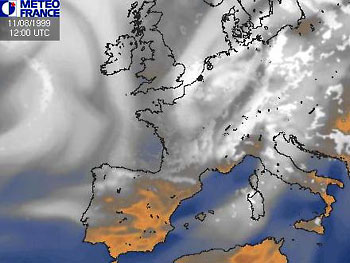 The
forecast issued by The Met. Office on
August 10th was as follows: "Southwest England is expected to be generally
overcast. Early in the morning the cloud will be fairly high level. However,
low cloud will increase from the west during the morning, and bring the risk
of showers and rain. The chances of having a good view of the eclipse in Cornwall
and the Isles of Scilly is a mere 15%, and only slightly higher in south Devon.
Heading into mainland Europe, there should be a moderate chance of viewing
the eclipse in northeast France, Luxembourg and west of the Rhine Valley in
southern Germany, with the odds here at 40 to 50%. However, plenty of cloud
is expected over the rest of southern Germany, Austria and Hungary, where scattered
thundery showers will develop during the course of the morning. So there is
only a 20 to 30% chance of seeing the totality here." (bold emphasis is
mine)
The
forecast issued by The Met. Office on
August 10th was as follows: "Southwest England is expected to be generally
overcast. Early in the morning the cloud will be fairly high level. However,
low cloud will increase from the west during the morning, and bring the risk
of showers and rain. The chances of having a good view of the eclipse in Cornwall
and the Isles of Scilly is a mere 15%, and only slightly higher in south Devon.
Heading into mainland Europe, there should be a moderate chance of viewing
the eclipse in northeast France, Luxembourg and west of the Rhine Valley in
southern Germany, with the odds here at 40 to 50%. However, plenty of cloud
is expected over the rest of southern Germany, Austria and Hungary, where scattered
thundery showers will develop during the course of the morning. So there is
only a 20 to 30% chance of seeing the totality here." (bold emphasis is
mine)
This seemed faintly encouraging, however the cloud cover forecast issued by
Meteo-France on August 10th (right image)
looked decidedly unpromising, with an unsettled weather pattern covering virtually
the whole of western Europe. It seemed to indicate that any chance of photographing
the eclipse from Austria westwards would be through the sheer luck of their
being temporary holes in the cloud, rather than their being any real prospect
of finding clear skies. However based on the Met. Office forecast, I decided
that the 40 to 50% chance of photographing the eclipse in northeast France was
better than in most places and that I would do best by staying put.
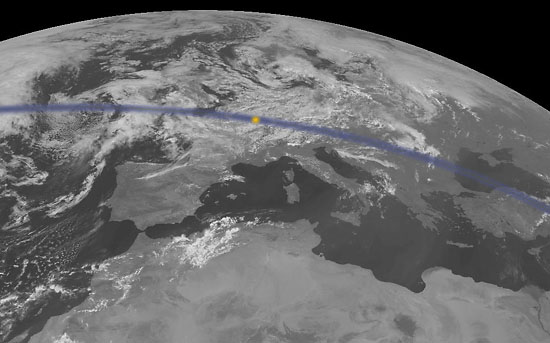 In
the event the Meteo-France cloud cover forecast proved quite accurate. The satellite
image on the right from EUMETSAT shows
the actual cloud cover some two hours after the time of totality at my local
site. I have shown the path of totality by the blue curve with the yellow dot
marking my local site in northeastern France.
In
the event the Meteo-France cloud cover forecast proved quite accurate. The satellite
image on the right from EUMETSAT shows
the actual cloud cover some two hours after the time of totality at my local
site. I have shown the path of totality by the blue curve with the yellow dot
marking my local site in northeastern France.
As predicted, virtually the whole totality path in north-western Europe was
cloud covered. Probably the thinnest cloud was in the middle north of France,
from Reims northwest towards the channel coast, but even here viewers were fortunate
if they saw the whole of totality. As it happened there was a location only
4 miles north of my site where a temporary hole in the clouds enabled viewers
to see totality. I was not so lucky.
On The Day
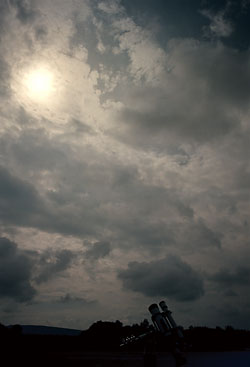 During the morning there were odd
patches of semi blue sky which enabled me to calibrate the mount and align the
telescopes on the sun. The photograph on the left illustrates the kind of sky
that prevailed during this period. The photograph was taken about one hour prior
to totality. The photograph was exposed to show the sky conditions and as a
result the landscape is under exposed.
During the morning there were odd
patches of semi blue sky which enabled me to calibrate the mount and align the
telescopes on the sun. The photograph on the left illustrates the kind of sky
that prevailed during this period. The photograph was taken about one hour prior
to totality. The photograph was exposed to show the sky conditions and as a
result the landscape is under exposed.
Totality
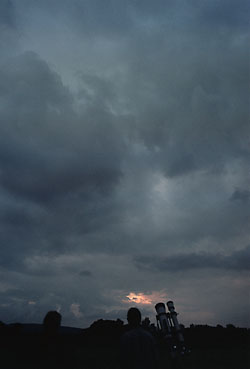 Cloud gradually thickened during
the latter part of the morning and by the time of totality cloud cover was complete.
The photograph on the right shows the sky conditions during mid totality. The
eclipsed sun is located about 1/4 of the way from the top of the photo towards
the middle. The telescopes were accurately tracking the sun throughout the eclipse,
even though cloud cover was so complete as to preclude any photography. The
sky has a strong blue cast in this photograph which must be associated with
the low light level since it did not appear this blue in reality. This gives
the impression that there were areas of clear sky towards the top of the photo,
though in reality the whole sky was strongly overcast.
Cloud gradually thickened during
the latter part of the morning and by the time of totality cloud cover was complete.
The photograph on the right shows the sky conditions during mid totality. The
eclipsed sun is located about 1/4 of the way from the top of the photo towards
the middle. The telescopes were accurately tracking the sun throughout the eclipse,
even though cloud cover was so complete as to preclude any photography. The
sky has a strong blue cast in this photograph which must be associated with
the low light level since it did not appear this blue in reality. This gives
the impression that there were areas of clear sky towards the top of the photo,
though in reality the whole sky was strongly overcast.
Complete site details are as follows:
Longitude : 7° 45' E : Latitude : 49° 0' N
Duration of Eclipse : 2m 19.8s
1st Contact : 11h 11m 15.3s
2nd Contact : 12h 30m 27.3s
Mid Eclipse : 12h 31m 37.2s
3rd Contact : 12h 32m 47.1s
4th Contact : 13h 54m 17.8s
Instruments
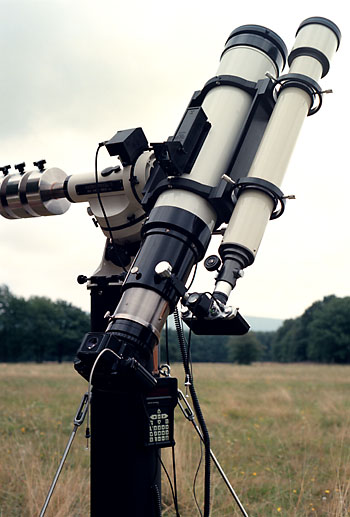 The photographic instruments and
other equipment consists of:
The photographic instruments and
other equipment consists of:
- AP 900 GTO mount + Portable Pier
- AP 155 EDF f/7 refractor with 4" focuser and integral field flattener
- Pentax 6x7 medium format camera (attached to 155 EDF)
- AP 80mm f/11 guidescope
- Nikon F2 35mm camera (attached to guidescope)
This photograph, taken about two hours after totality, shows the equipment as
it was set up for the eclipse. The Pentax 6x7 was loaded with Fuji Reala ISO 100
film, 220 format. The Nikon was loaded with Fuji Velvia ISO 50 35mm format.
The AP 900 mount was quite accurately polar aligned, enabling the cameras to
stay accurately centered on the sun throughout the eclipse and well beyond.
The AP 155 EDF is a powerful and optically superb instrument with which to
photograph an eclipse, and the use of the medium format camera should enable
the extreme outer corona to be captured while maintaining superb image quality
over the entire 6x7 frame.
I decided to use the AP guidescope as an additional imaging instrument. I ran
test exposures of the moon which confirmed the excellent quality of the optics.
The reason for doing this was to supplement any exposures taken with the Pentax
that might have suffered slightly from shutter vibration. Although the Pentax
is an ideal instrument for capturing wide field images of the corona, the amount
of shutter vibration (even with the mirror locked up) might have slightly blurred
detail in shots of the prominences. On the other hand the Nikon with the mirror
locked had no perceptible vibration and the test images were always sharp. Hence
the idea with the Nikon was to take only a few shots of the prominences to possibly
stack with the Pentax shots rather than to replicate any of the main sequence
that would be taken with the Pentax. The Nikon was also a very useful backup
camera - had anything gone wrong there would have been no time to swap cameras
and refocus (totality lasted only 2m 20s at this site).
Setting Up and Aligning
Setting up on eclipse day
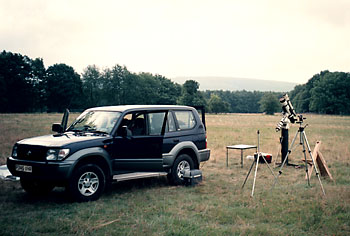 |
I had identified a large private farm estate at about 1,000 ft on the centreline.
The owners kindly allowed me onto the estate two days prior to the eclipse and
to leave the mount overnight. This was very useful for getting the mount aligned,
since poor weather may have prevented alignment on one or other of the previous
days. Since we were on private land it was quite safe to leave the mount in
situ overnight suitably covered against the weather. The original idea was to
polar align the mount at night but neither of the two previous nights had been
clear enough. Therefore I had to resort to drift alignment on sunspots. There
are other methods of polar alignment but nothing is as accurate as the drift
method. On Monday afternoon I was able to align the altitude with the sun low
in the west. During Tuesday I was able to align the azimuth with the sun close
to the meridian. Much of the time the sun was partially cloud covered but this
did not seriously affect the ability to discern sunspots. The alignment process
worked well and the sun stayed accurately centered in the camera viewfinders
over a 4 hour period on eclipse day.
Power Considerations
Now where did I hide that filter?..
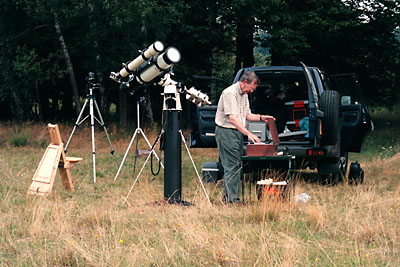 |
This was the first time that I had attempted to operate this level of equipment
fully remote. Powering the equipment was obviously an important consideration.
Most people use deep cycle batteries for remote power, but frankly there was
not enough room on board for a large battery. However this vehicle has two heavy
duty batteries wired in parallel with special 120W power sockets fitted front
and rear. It is clearly designed for delivering power to remote equipment. I
ran a test which drained 3 amps continuously for 8 hours. This had no measurable
impact on battery capacity or the ability to start the engine. I then looked
for ultra low resistance cable to run between the vehicle and the telescope.
I found this in the form of heavy duty speaker cable which has thick rope conductors
of pure copper. The full loop resistance of the desired length was less than
the 0.3 ohm minimum resistance I could record using a digital ohmmeter. It seemed
as though it should work well, and so it proved - the telescope performed perfectly
throughout.
Exposures and Compositing
That's it!.. I've had enough of this cloud!
(controller display is hard to see in broad daylight unless
shrouded)
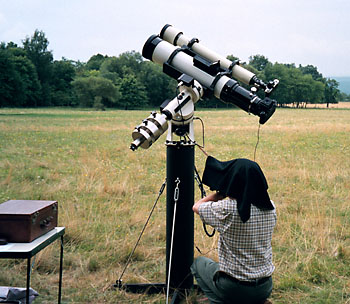 |
I had intended to digitally composite multiple exposures according to the method
described by Pellett in the January 1998 issue of Sky and Telescope. This and
other techniques are described in a superb article by Jerry
Lodriguss.
I had identified the following exposure sequence as being appropriate for the
f/7 refractor using Reala ISO 100 film:
1/1000s, 1/250s, 1/60s, 1/15s, 1/4s, 1/2s, 1s, 4s, 8s.
This is the full sequence as recommended by Fred
Espenak, with the addition of a deep 8 second shot to bring out the extreme
outer corona, all of which I should have been able to capture on medium format.
In addition I had planned an exposure of 1/60s at both 2nd and 3rd contact
to try to capture the Diamond Ring.
In addition I had intended to run the following exposures on the f/11 guidescope
using Velvia ISO 50 film: 1/250s, 1/60s, 1/15s, 1/4s
I had intended to capture only prominence detail at 1/250s - the other exposures
were for backup. I decided to use Velvia for the Nikon because the superb definition
and contrast should have helped bring out fine detail in the prominences. Since
there would be little or no corona in this exposure I did not foresee any difficulty
in stacking it with the main sequence corona images from the Pentax 6x7.
Testing and Rehearsing
All aspects of the equipment and the techniques to be used were thoroughly tested.
Focusing needs special mention since it can be something of a thorny issue
for eclipse photography. Generally the advice I received was that a solar filter
placed in front of the optics will not change the focus point. Like everything
else, I tested this. I focused accurately on the Sun, slewed to Venus, removed
the filter, and checked focus. I also tested it the other way round - I focused
accurately on Venus, replaced the solar filter, slewed to the Sun, and checked
focus. I ran these tests repeatedly on two separate days. Unfortunately each
time I ran this test I noticed a slight change in the focus point. Later on
when I was talking to Roland Christen he informed me that glass filters do change
the focus point - the only ones that do not are the Mylar types. Since I was
using glass Orion filters (for both scopes) this seemed to explain the result
I was seeing. I therefore decided that I would try to focus on Venus about 15
minutes before totality. This worked alright during the practice sessions but
by the time of the eclipse Venus was close to the Sun and very difficult to
see unless the sky was clear and dew shields were in place. It worked alright
on the Monday prior to the eclipse but on eclipse day there was far too much
cloud. I had no option but to focus on the sun, with solar filters in place,
during the odd spells when the sun could be seen. My advice: if you are using
a mount with pointing ability, try to focus on a bright planet with the solar
filter removed. It may make a difference in achieving fine detail in those prominence
shots.
Internal Reflections & Shutter Vibration
I ran three sets of test exposures of the full moon using both the Pentax on
the AP 155 EDF and the Nikon on the Guidescope - about 100 exposures in all.
I ran exposures all the way from 1/1000s to 4s using exactly the same telescope
configuration and film as for the eclipse. The deep 4 second exposure, although
grossly over exposed, was to test for possible internal reflections from the
field flattener. There was no sign of reflections at all - very encouraging.
I carefully studied all the exposures for signs of shutter vibration. This was
important, because even with the mirror locked up, the Pentax still exhibited
some vibration when the shutter opened. The results looked good and I could
not detect any obvious sign of blurring due to shutter vibration. Nonetheless
I decided to replicate the prominence shot with the Nikon in case it came out
sharper.
Film Characteristics
I also tested the films for colour balance, saturation, graininess, etc. My
ultimate choice of Fuji Reala for the Pentax was based more on availability
than anything else - there are not many fine grained colour negative films available
in 220 format. I was originally going to use Fuji Velvia but I decided to switch
to colour negative film following advice on APML that it was very difficult
to achieve smooth composition of corona shots owing to the limited dynamic range
and high contrast of Velvia.
Fuji Velvia (ISO 50) is an astonishing film - it appears to be virtually grainless
and has the most amazing definition (edge enhancement effect) and colour saturation.
Images definitely have that 'better than reality' look, however some of the
more subtle colours can look a bit too unreal which may be a problem for the
purists among us. The real problem with Velvia (for normal daylight photography)
is that skin tones are quite dreadful - unless your subject has unusually smooth,
pale skin, it will normally come out looking red and blotchy. It is a film for
landscapes and nature photography rather than portrait photography. However
it is exactly these qualities that made me consider it a good film for capturing
prominence detail.
Fuji Reala (ISO 100), as its name implies, seems to have very natural looking
colours. Results look impressive enough (the sky shots and Instruments shot,
above, were taken with this film) though it's possible that a touch more vividness
might be better for eclipse photography. I was actually quite disappointed with
the definition and graininess of this film. The definition is nothing like the
same as Velvia and graininess seems quite coarse for a modern ISO 100 film.
It's certainly finer than a ISO 400 film, but I would not classify it as a fine
grained film. It seems to fit the medium-fine grained category. I decided to
use it for the corona shots because by the time I had completed the testing
there was no time left to test anything else. It would certainly do the job,
but for the next eclipse I think I would investigate a fine grained Kodak alternative.
Equipment Testing
The operation of the mount was tested thoroughly before departure using the
vehicle high power sockets and special low resistance cable that I constructed
(described under Power Considerations, above). The equipment itself is used
regularly for astrophotography so I already had a high level of confidence that
it would work without problems. The only thing that really needed testing was
the operation of the mount using the vehicle power source.
Polar Alignment
The method of drift aligning on sun spots worked well but I think it may be
unnecessarily fussy and time consuming for eclipse photography. On a future
eclipse expedition I would try to obtain the polar alignment scope for the AP
900 since this would speed up the polar alignment process considerably and should
be quite accurate enough for eclipse photography.
Rehearsal of Events
The schedule of events for eclipse day is listed below. This was printed out
in large type in duplicate - one copy for my wife and one copy for me. The full
photographic sequence was rehearsed in full at the telescope a total of 10 times.
We consistently managed to complete the totality sequence within 50 seconds,
though I allowed 1 minute because things always take longer during the real
event. This would have allowed more than half the eclipse time for viewing the
sun through binoculars, etc. At 2 minutes 20 seconds it was a short eclipse,
so the timing of everything had to be rigorous and to the second.
09h 00m 0s Arrive - Set Up
11h 00m 0s Ready to Roll
11h 11m 15.3s 1st Contact P : 284° Z : 318°
12h 00m 0s Check all telescope functions
Start Camcorder
Set land camera
12h 15m 0s Focus on Venus
12h 25m 0s All set!
12h 29m 0s Remove Solar Filters
12h 30m 26s Diamond Ring Pentax 1/60 s
12h 30m 27.3s 2nd Contact P : 103° Z : 121°
12h 30m 30s Prominences Pentax 1/1000 s
: Corona - 0.1 Rs Pentax 1/250 s
: Corona - 0.2 Rs Pentax 1/60 s
: Corona - 0.5 Rs Pentax 1/15 s
: Corona - 1.0 Rs Pentax 1/4 s
: Corona - 2.0 Rs Pentax 1/2 s
: Corona - 4.0 Rs Pentax 1 s
: Corona - 8.0 Rs Pentax 4 s
: Corona - Extreme Pentax 8 s
12h 31m 25s Prominences Nikon 1/250 s
: Corona - 0.1 Rs Nikon 1/60 s
: Corona - 0.2 Rs Nikon 1/15 s
: Corona - 0.5 Rs Nikon 1/4 s
12h 31m 35s Eclipse Landscape Nikon FM2 1 s f/4
Group Photo
12h 31m 37.2s Mid Eclipse
12h 31m 40s View Eclipse Binoculars, etc
12h 32m 40s Prepare Diamond Ring
12h 32m 47.1s 3rd Contact P : 289° Z : 306°
12h 32m 48s Diamond Ring Pentax 1/60 s
12h 33m 0s Replace Solar Filters
13h 54m 17.8s 4th Contact P : 107° Z : 101°
I believe that I had thought of everything - even to the extent of marking
the shutter speeds to be used on the shutter speed dial with an ultra-fine white
marker pen, and stringing a small flashlight around my neck in case of difficulty
of seeing things in the dark. In the event the latter proved unnecessary, though
having the shutter speeds pre-marked proved to be a great idea.
Of course, all cameras must be pre-loaded, pre-focused, all set and completely
ready to go. In fact this applies to everything - during a 2 minute 20 second
eclipse there is only time to go through a pre-rehearsed sequence - there is
no time to do anything else at all.
Finale
Gracing an Archway of the Chateau du Fleckenstein
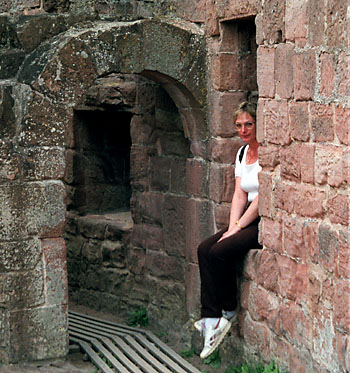 |
Total dependence on the weather is just one of 101 things that make astronomy
difficult. But although there was obvious disappointment that the main objective
could not be achieved, there was also deep satisfaction that everything that
was subject to human failure worked absolutely according to plan. In fact nothing
went wrong at all. Now here's a secret - I had already visited this site and
identified the exact spot where the telescope would go one month previously.
It's not often possible to identify an exact spot that will be cloud covered
one month in advance! :-)
Here's someone who, by mutual consent, was immediately promoted from her previous
title of 'Wife', to the lofty title of 'Chief Astronomical Assistant' following
her sterling achievements that were clearly 'Beyond the Call of Duty' in providing
untold moral support and efficiently managing the event, even to the extent
of correctly identifying various astronomical accessories that were needed at
ultra short notice! :-)
Here she is gracing one of the archways of the ancient Chateau du Fleckenstein,
fully within the path of totality, and only 3 miles north of our eclipse site.
We wondered what the ancient builders of this castle would have made of this
eclipse .. people who had never even heard about eclipses, let alone seen one.
What would they have thought, when during the middle of the day, the sun's light
suddenly diminished, then went out altogether? What sort of terror may have
gone through their minds?
All text and images Copyright © 1997-2022 by Philip
Perkins. All rights reserved.
 The
forecast issued by The Met. Office on
August 10th was as follows: "Southwest England is expected to be generally
overcast. Early in the morning the cloud will be fairly high level. However,
low cloud will increase from the west during the morning, and bring the risk
of showers and rain. The chances of having a good view of the eclipse in Cornwall
and the Isles of Scilly is a mere 15%, and only slightly higher in south Devon.
Heading into mainland Europe, there should be a moderate chance of viewing
the eclipse in northeast France, Luxembourg and west of the Rhine Valley in
southern Germany, with the odds here at 40 to 50%. However, plenty of cloud
is expected over the rest of southern Germany, Austria and Hungary, where scattered
thundery showers will develop during the course of the morning. So there is
only a 20 to 30% chance of seeing the totality here." (bold emphasis is
mine)
The
forecast issued by The Met. Office on
August 10th was as follows: "Southwest England is expected to be generally
overcast. Early in the morning the cloud will be fairly high level. However,
low cloud will increase from the west during the morning, and bring the risk
of showers and rain. The chances of having a good view of the eclipse in Cornwall
and the Isles of Scilly is a mere 15%, and only slightly higher in south Devon.
Heading into mainland Europe, there should be a moderate chance of viewing
the eclipse in northeast France, Luxembourg and west of the Rhine Valley in
southern Germany, with the odds here at 40 to 50%. However, plenty of cloud
is expected over the rest of southern Germany, Austria and Hungary, where scattered
thundery showers will develop during the course of the morning. So there is
only a 20 to 30% chance of seeing the totality here." (bold emphasis is
mine) In
the event the Meteo-France cloud cover forecast proved quite accurate. The satellite
image on the right from
In
the event the Meteo-France cloud cover forecast proved quite accurate. The satellite
image on the right from  During the morning there were odd
patches of semi blue sky which enabled me to calibrate the mount and align the
telescopes on the sun. The photograph on the left illustrates the kind of sky
that prevailed during this period. The photograph was taken about one hour prior
to totality. The photograph was exposed to show the sky conditions and as a
result the landscape is under exposed.
During the morning there were odd
patches of semi blue sky which enabled me to calibrate the mount and align the
telescopes on the sun. The photograph on the left illustrates the kind of sky
that prevailed during this period. The photograph was taken about one hour prior
to totality. The photograph was exposed to show the sky conditions and as a
result the landscape is under exposed. Cloud gradually thickened during
the latter part of the morning and by the time of totality cloud cover was complete.
The photograph on the right shows the sky conditions during mid totality. The
eclipsed sun is located about 1/4 of the way from the top of the photo towards
the middle. The telescopes were accurately tracking the sun throughout the eclipse,
even though cloud cover was so complete as to preclude any photography. The
sky has a strong blue cast in this photograph which must be associated with
the low light level since it did not appear this blue in reality. This gives
the impression that there were areas of clear sky towards the top of the photo,
though in reality the whole sky was strongly overcast.
Cloud gradually thickened during
the latter part of the morning and by the time of totality cloud cover was complete.
The photograph on the right shows the sky conditions during mid totality. The
eclipsed sun is located about 1/4 of the way from the top of the photo towards
the middle. The telescopes were accurately tracking the sun throughout the eclipse,
even though cloud cover was so complete as to preclude any photography. The
sky has a strong blue cast in this photograph which must be associated with
the low light level since it did not appear this blue in reality. This gives
the impression that there were areas of clear sky towards the top of the photo,
though in reality the whole sky was strongly overcast.  The photographic instruments and
other equipment consists of:
The photographic instruments and
other equipment consists of:


